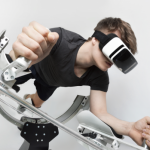 It’s hard to shake the impression that virtual reality is a technology looking for a solution, especially outside of the gaming community. Nonetheless, it’s a technology that still has its supporters, and as such people are still working to improve it. The latest effort comes from a team at the University of Göttingen whose research aims to make VR more user friendly.
It’s hard to shake the impression that virtual reality is a technology looking for a solution, especially outside of the gaming community. Nonetheless, it’s a technology that still has its supporters, and as such people are still working to improve it. The latest effort comes from a team at the University of Göttingen whose research aims to make VR more user friendly.
The system aims to overcome a flaw in VR-based testing that requires humans to be recruited as guinea pigs, which can be both costly and time consuming. The German team have constructed an autonomous system that removes the need for humans to be deployed as test subjects for VR platforms.
The system was tested in a couple of scenarios. The first of these required a user to fetch a coffee cup and place it under the coffee machine before pressing the right button to get their drink. The second was a photocopier like scenario. In both, the individual activities and movements of test subjects were recorded to help create ‘activity lists’. The system was then able to automatically search through these lists for typical user behaviors. This as then followed by a final step where the behavior was evaluated by the program to try and spot any irregularities.
Autonomous testing
“This makes it possible, among other things, to determine how well users of a specific VR system are guided by it and whether they usually have to perform ergonomically inconvenient procedures during its operation,” the researchers explain.
The researchers believe that their system is able to recognize any interaction problems that may cause users to have to repeat or abort processes a number of times. The project builds upon previous work from the university on automated usability evaluation technology for websites and desktop software.
“In contrast to manual evaluations, automated evaluations can take place more frequently, more cost-effectively and without special preparation both during the development of a VR system and after its release into the market. This gives developers the opportunity to consider VR improvements quickly for the next software update,” the researchers explain.